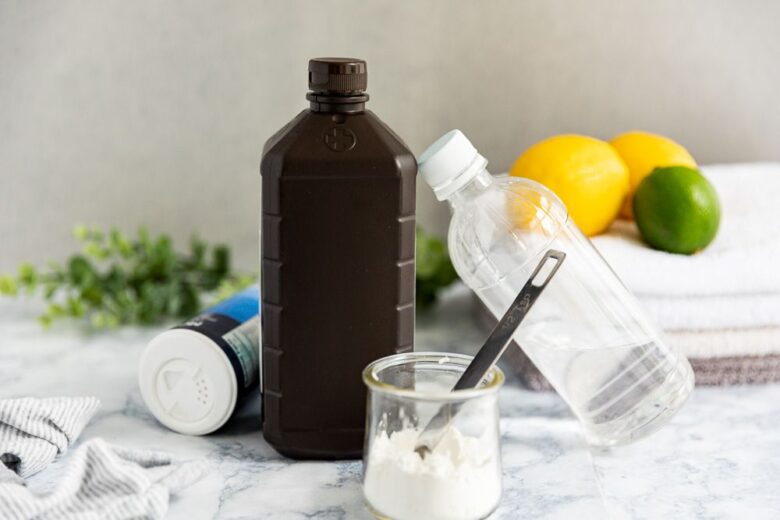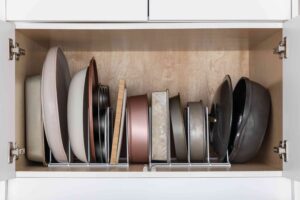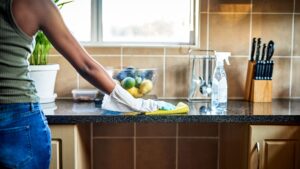Keeping your kitchen clean can be an ongoing battle, especially when you’re faced with stains that you can’t remove. Stains always seem to appear on countertops, floors, and appliances, whether from cooking spills, sauce splatters, or the mess left behind after a botched cooking experiment. With a few simple ingredients and the right knowledge, you can tackle these stains and give your kitchen a whole new look. This guide will show you six easy ways to remove kitchen stains to make cleaning a breeze.
1. Vinegar and Baking Soda Paste:
Baking soda and vinegar are two of the best cleaning agents that can be used separately, but when mixed they can work wonders on tough kitchen stains. To make the paste, simply mix vinegar and baking soda until the paste thickens. The paste should be applied to the stain and left on for 15 to 20 minutes. Then gently scrub the stain with a sponge or cloth and then rinse with water. This method is particularly effective at removing grease and grime from oven, stove, and countertop surfaces.
2. Lemon Juice and Salt:
Lemon juice naturally removes grease and stains, making it perfect for removing stubborn stains in the kitchen. When mixed with salt, it forms a strong, coarse paste that can remove even the toughest dirt. First, sprinkle salt on the stain. Then squeeze fresh lemon juice over the salt until it forms a paste. While the stain is still wet, scrub the stain with a sponge or brush. Rinse the surfaces with water and enjoy how clean they are.
3. Hydrogen Peroxide:
This is another all-purpose cleaner that works great on kitchen stains, especially organic stains such as those from food or wine. Apply a small amount of hydrogen peroxide to the stain and let it sit for a few minutes. Hydrogen peroxide penetrates the stain and removes it. Then absorb excess liquid with a clean cloth or sponge and repeat if necessary. First, do a spot test in an area where it won’t draw attention, as hydrogen peroxide can sometimes change the color of some surfaces.
4. Dish Soap and Hot Water:
Dish soap and hot water can sometimes remove everyday stains and spills. Add a few drops of dish soap to warm water to make a soapy mixture. Then place the mixture on the stain. To prevent stains from spreading, gently scrub from the outside with a sponge or cloth. Rinse well with water and rinse again if necessary until the stain has disappeared. This method is safe for most surfaces and is ideal for removing grease and food stains from countertops, sinks, and appliances.
5. Baking Soda and Hydrogen Peroxide:
Baking soda and hydrogen peroxide work well together to remove stains and clean up even the messiest kitchens. First, sprinkle baking soda on the stain. Then spray or pour the hydrogen peroxide over the baking soda until it forms a paste. After letting it sit for a few minutes, wipe the stain away with a sponge or brush. Rinse it off with water and the results are amazing.
6. White Vinegar and Dish Soap:
White vinegar and dish soap are two well-known cleaning products that work well in removing stains in the kitchen. Make a cleaning solution by mixing equal parts white vinegar and dish soap with warm water. Then apply the cleaning solution to the stain. Let it sit for a few minutes so it can penetrate the stain. Then use a sponge or brush to gently scrub. Rinse well with water and rinse again if necessary until the stain has disappeared. This method is particularly effective at removing grease and grime from kitchen countertops, cabinets, and appliances.
Conclusion
With these six easy ways to remove kitchen stains, you can clean up even the worst spills and splatters with ease. Whether you prefer natural products like lemon juice and vinegar or common household items like dish soap and hydrogen peroxide, there is a way to clean every stain and surface. Don’t let the mess in the kitchen get you down. Instead, put on your cleaning supplies today and make your kitchen shine again.
FAQs
1. What are the most common stains in the kitchen?
In the kitchen, grease, oil, spilled food, coffee or tea stains, wine, ketchup, and other things can leave their mark. Typically, these stains are found on floors, appliances, kitchen appliances, and countertops.
2. Should I not use these methods to remove stains from certain surfaces?
Most of the methods mentioned are safe for most surfaces, but it’s always a good idea to test them in a small hidden area first. This is especially important for surfaces that are prone to damage, such as marble or granite. Most importantly, avoid using rough materials on surfaces that scratch easily, such as stainless steel.
3. Are these methods effective on old stains?
You can use these methods on both new and old stains. Older stains, on the other hand, may require more time and work to be completely removed. It may help to leave the cleaning solution on the stain longer or perform these steps several times.
4. What if none of these methods can remove the stain?
If using these techniques does not remove the stain, a specialist or specialized product may be required to clean it. In addition, some stains may be more difficult to remove completely, especially if they have penetrated porous surfaces.
5. Are these stain removal methods safe to use in food preparation areas?
Yes, most of the methods in this guide use common household items that are safe to use near food preparation areas. However, it is important to rinse the surface after cleaning to ensure no residue is left behind.
6. Can I use more than one of the above methods to remove more stubborn stains?
Each method can be used separately, but you can use several methods at the same time to remove very stubborn stains. For example, you can start by making a paste of vinegar and baking soda and then use hydrogen peroxide to make it cleaner.


